No evidence cop’s injuries were ‘self-inflicted’ following fatal shooting, court hears
There is no evidence to suggest a wound that may have been sustained by Adam Eberl in an ultimately fatal struggle with Kumanjayi Walker was instead ‘self-inflicted’, a court has heard.
Northern Territory
Don't miss out on the headlines from Northern Territory. Followed categories will be added to My News.
THERE is no evidence to suggest a wound that may have been sustained by Adam Eberl in an ultimately fatal struggle with Kumanjayi Walker was instead “self-inflicted”, a court has heard.
Sergeant Eberl’s partner in the arrest, Constable Zach Rolfe, has pleaded not guilty to all charges in the Supreme Court after shooting Mr Walker to death in Yuendumu in November 2019.
Earlier this week, Sgt Eberl told the court he didn’t notice the scratch to his arm until “a day or so later”.
But on Friday, forensic pathologist Paull Botterill, told the jury while Eberl’s scratch “could have been self-inflicted”, “there appears to be no features, such as hesitation marks, that might specifically suggest self-infliction”.
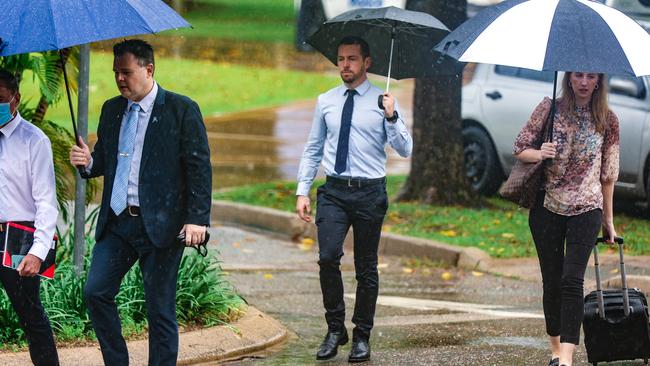
“People who harm themselves will generally harm themselves in a way that they can easily access and usually those points of harm are more superficial, they’re less deep and that’s because it hurts,” he said.
“Sometimes there is an associated hesitancy to injure oneself so that even more superficial, preliminary attempts can show up as well, we call them ‘hesitation marks’.
“In truth, it’s possible that such an injury could be self-inflicted but there’s no features that would really suggest that to me, necessarily.”
Dr Botterill also told the court photographs taken of the wound several days after the shooting were consistent with it having been sustained during the attempted arrest.
Crown prosecutor Philip Strickland SC told the court he expects to wrap up the case against Rolfe on Tuesday, after which the defence team may or may not choose to lead evidence before both sides make their closing addresses.
The trial continues on Monday.
‘Low threat’: Court hears from biomechanics expert
KUMANJAYI Walker “may have been a direct physical threat” to Adam Eberl when Zach Rolfe shot him the first time but was “likely a low threat” at the time of the second and third shots, a court has heard.
Rolfe has pleaded not guilty to all charges after fatally shooting the 19-year-old as he and now Sergeant Eberl tried to arrest him for a prior assault on police in Yuendumu in 2019.
On Friday, biomechanics expert Andrew McIntosh, told the court “the potential existed for Mr Walker to cause injury or harm to Constable Eberl or Constable Rolfe” with a pair of scissors he was holding when the struggle began.
But Dr McIntosh said once Sgt Eberl and Mr Walker separated from Rolfe, “the threat to Rolfe diminished while (Sgt) Eberl was restraining and controlling” Mr Walker.
He said while the body worn camera footage was “inconclusive”, on balance “Mr Walker was unlikely to be a direct threat to Rolfe at the time of the second and third gunshots”, while Sgt Eberl was attempting to ground stabilise him, and “likely a low threat” to Sgt Eberl.
Dr McIntosh agreed with Crown prosecutor Philip Strickland SC, that even if only Mr Walker’s upper arm was pinned under him by Sgt Eberl “this greatly constrains the potential movements of his forearm and hand and the use of the scissors as a weapon”.
“Most of the movement of the right arm is lost because it’s blocked by the mattress,” he said.
“It limits, let’s say by half, the amount of movement of your arm in total and restricts it to your forearm and wrist because essentially you can only move your arm forward, away from your body.
“It would reduce the range of motion that he could move the scissors through and his reach with the scissors and it would reduce his ability to generate force to push through the scissors with if he engaged with Mr Eberl.”
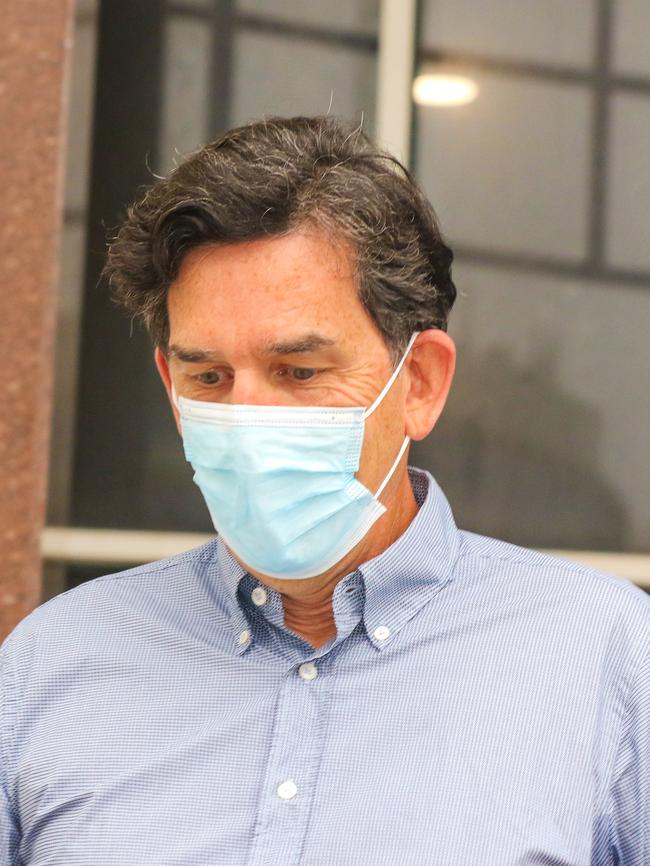
On Friday, Dr McIntosh handled the actual scissors in the witness box for the first time, opening and closing them and turning them over in his hands.
In cross examination, defence barrister David Edwardson QC, asked Dr McIntosh if deployed to a region of the body containing a major artery, they “have the potential to be lethal”.
“I agree with that, yes,” he replied.
Dr McIntosh also agreed with Mr Edwardson that his opinions were based on what could be seen on the body worn camera footage, in which Sgt’s Eberl is obscuring Mr Walker’s arm.
“You cannot see Mr Walker’s right forearm or arm at all (in the footage) when Mr Eberl’s on top of him,” he said.
He also accepted that his perception of the level of threat to the officers based on viewing the footage might be “quite different” to their own perception at the time.
The trial continues.
Pointier scissor blade exposed when Zach Rolfe stabbed
THE scissors Kumanjayi Walker used to stab Constable Zach Rolfe before he shot and killed him must have been open at the time, with only the pointier of the two blades capable of penetrating his clothing, a court has heard.
Rolfe has pleaded not guilty in the Supreme Court to murdering Mr Walker, as well as two alternative charges, during an attempted arrest in Yuendumu in 2019.
On Thursday, Australian Federal Police forensic analyst, Timothy Simpson, told the court he conducted experiments with the scissors on Rolfe’s police uniform shirt, which he said excluded the blunter of the two blades as having caused the stabbing damage.
“The resulting damage from that action with the (blunter) blade was firm compression of the fabric, but no penetration was able to be achieved,” he said.
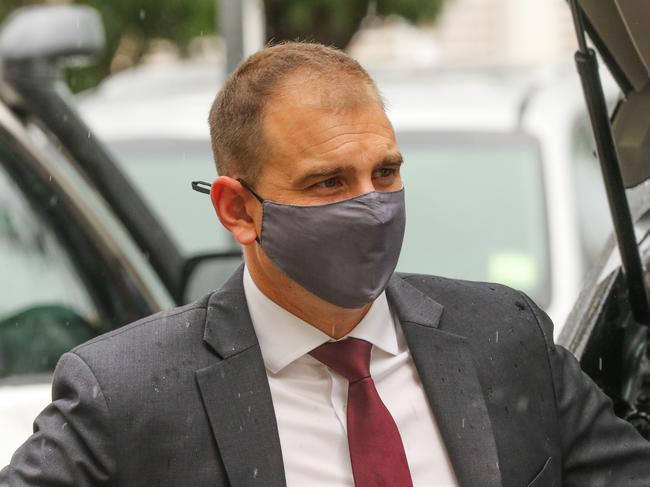
Mr Simpson said on inspecting the damage caused during the struggle itself he concluded it could only have been caused by an “exposed cutting edge”, rendering any experiments on the closed scissors unnecessary.
He said while it was sometimes the case that scissors could “overclose” so the cutting edge was slightly exposed on the opposite side, that was not possible for the scissors in question.
“The damage that I observed needed a cutting edge exposed and when presented with the scissors in a closed position, neither of the cutting edges were exposed,” he said.
“In this particular case, with these scissors, they are manufactured in such a way that is of high quality, being that the blade thickness themselves is very thick and also the hinge quality is of a good quality so it was very difficult to achieve that over-closing mechanism that we’re talking about.”

Mr Simpson said he conducted the experiments using a “pork belly substrate” under the clothing to simulate human flesh, but didn’t measure how deeply the 50mm blade penetrated the pork.
Under cross examination by defence barrister, David Edwardson QC, however, he said, from memory, the pointier blade penetrated the pork belly “about three quarters of the way in”, albeit “in ideal circumstances, with moderate force”.
Mr Simpson said his experiments had also found the pointier blade could not be excluded as having caused damage to Constable Adam Eberl’s shirt during the arrest, “in a downward stabbing motion”.
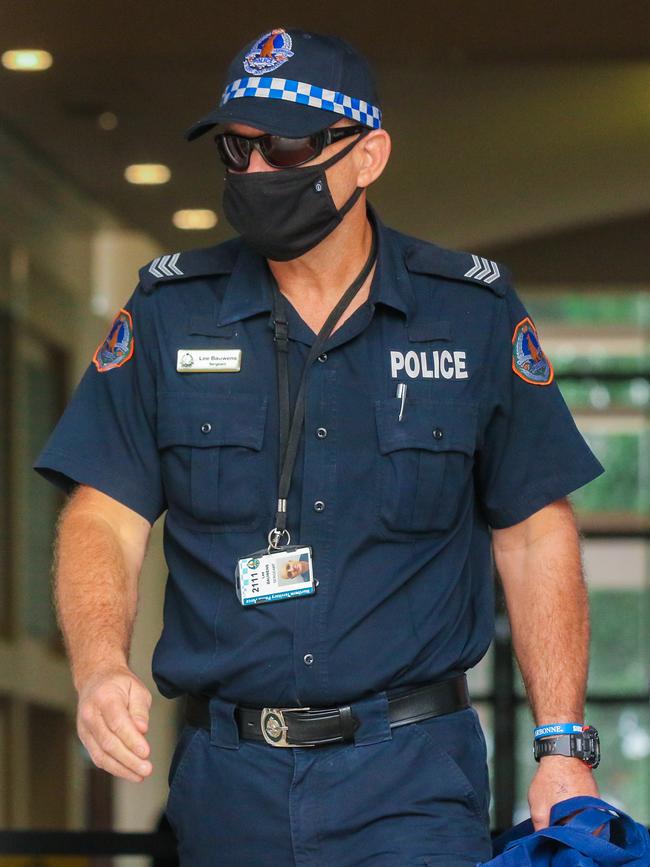
Earlier on Thursday, officer in charge of Rolfe’s Immediate Response Team, Sergeant Lee Bauwens, demonstrated training police underwent to prepare for defending themselves against edged weapons in close proximity, known as the “shove and shoot”.
“At the range, a paper target is placed in a very close quarters to the person,” he said.
“On the command we are to simulate an attack from a knife, arm goes up to either push or deflect. At the same time, the firearm is drawn and shot from the hip area.
“So it’s an immediate drill to fire the gun as quickly as possible to counteract the knife attack.”
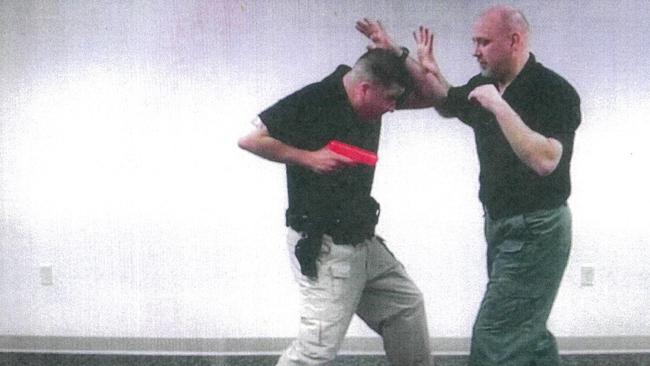
The trial continues on Friday.
Zach Rolfe’s team not considered a ‘high-risk’ deployment
THE Immediate Response Team sent to Yuendumu on the night Constable Zach Rolfe fatally shot 19-year-old Kumanjayi Walker was not considered a “high-risk deployment” that would warrant a specific arrest plan, a court has heard.
Sergeant Lee Bauwens, who is the officer in charge of the IRT but was not on duty at the time, took the stand in Rolfe’s Supreme Court murder trial on Wednesday, where he told jurors that in a high-risk situation, the unit’s “primary role is to cordon and contain”.
Sgt Bauwens said there was “only one situation” where IRT officers were authorised to take “affirmative or a tactical action”, known as an “Immediate Emergency Action”.
“In a declared high-risk incident where IRT are cordoning a situation, for example, maybe a house, and we are cordoning that unit, containing it until the arrival of a (Territory) Response Group, which is situated in Darwin, and geographically, that’s six hours to the next day away for a response, so we were approved to commit to an IEA if needed,” he said.

“And basically that means if, within the situation we are controlling, if a life-threatening situation would occur within that situation, we are authorised to enter, identify, challenge and form an arrest of an offender and save the lives of the person within the stronghold.”
Sgt Bauwens said high-risk deployments “have a very set protocol and very strict guidelines” and had to be authorised by an Assistant Commissioner, similar to TRG operations.
“When deployed, there are our four plans which we are authorised to act on and they are cordon and containment plan, arrest/surrender plan, negotiate an escort plan and an Immediate Emergency Action plan,” he said.
“Now, those formal plans which have to be filled out by a team leader, or a sergeant, then those plans are reviewed by a tactical commander, which generally could be the OIC of TRG, and then the Police Forward Commander has to approve those plans.”
But Sgt Bauwens said the team sent to Yuendumu on the night Mr Walker was killed was deployed as a “general response deployment” and “those plans don’t apply to that”.
Rolfe has pleaded not guilty to all charges and the trial continues on Thursday.
Arresting officer used ‘distraction strike’ to Kumanjayi Walker’s face during fatal arrest, court hears
THE NT Police officer who tried to arrest Kumanjayi Walker alongside Zach Rolfe before Rolfe shot and killed him has told a court how he used a “distraction strike” to punch him to the side of the head.
Rolfe has pleaded not guilty in the Supreme Court to all charges after fatally shooting the 19-year-old in Yuendumu in 2019.
On Wednesday, remote sergeant Adam Eberl told jurors what happened after Mr Walker started to struggle with him as he tried to place him under arrest on the evening of November 9.
“(I) basically took hold of his arm and I used a distraction strike to try and change his mindset and to give me a position so I could grab him to try and restrain him,” he said.
At the request of Crown prosecutor, Philip Strickland SC, Sgt Eberl stood in the witness box and demonstrated the closed fist strike to the side of Mr Walker’s face.
“It’s just a short strike, just to change his brain to thinking about that and not about resisting for a split second.”

Sgt Eberl said he then trapped Mr Walker’s left arm with his own arm, while using a “seatbelt hold” to take him to the ground and could see “some sort of pointed object” in his right hand.
“It was fairly dark, so to me, it could have been a stick or anything, I wasn’t too sure, but I knew it was sharp,” he said.
It was then Sgt Eberl said he heard what sounded like “a dull thud” that was “not the usual sound of a firearm that I’m used to”.
“I thought potentially it might have been (fellow officer) James Kirstenfeldt at the doorway with a beanbag shotgun,” he said.
“It’s hard to determine, at that stage, what I was thinking other than to try to take the defendant down.”
Sgt Eberl said he continued to try to restrain Mr Walker on the ground, “holding his left arm with my arms”, “so he couldn’t turn on me to try and get me with the weapon that he had in his hand”.
He said he had his weight on Mr Walker’s arm, while Mr Walker’s other arm was underneath his body, as he was trying to “ground stabilise” him when Rolfe fired the second and third shots.
“Usually ground stabilising (is) someone’s on their stomach and you put their arm completely on the ground to stop them getting up from that position, that’s what I was attempting to do,” he said.
Sgt Eberl said he believed Mr Walker was trying to move the whole time he was on top of him up until the third shot, but couldn’t say whether he did in fact move during that time.
He is then heard on body worn camera footage asking Rolfe “Did you … f***”, which he said was in reference to whether his arrest partner had shot Mr Walker.
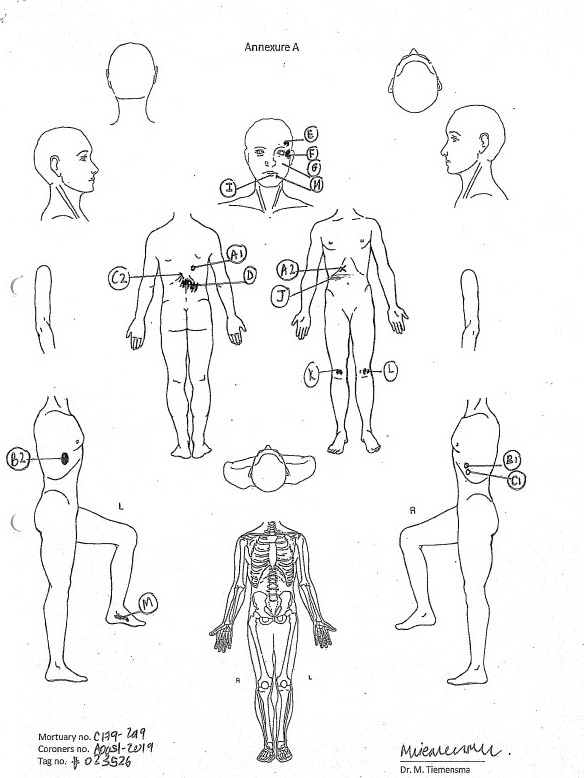
Under cross examination by defence barrister, David Edwardson QC, Sgt Eberl demonstrated the training he had received about what to do when an arrest target is attacking officers at close quarters with an edged weapon, as Mr Walker had done.
“As the person was to come down with the knife, the training was you raise up your arm, you drew your firearm from your holster, rotated it up at a 45 degree angle and fired into the subject to gain immediate incapacitation,” he said.
When asked how many times he was trained to fire the pistol, Sgt Eberl said: “As many times until the threat was no longer there”.
Sgt Eberl agreed that the footage showed that even after Mr Walker had been shot three times he was still “non-compliant” and resisting Rolfe’s attempts to remove the scissors from his hand.
He also agreed that when he is heard telling Mr Walker to “stop f***ing around or I’ll smash you”, that too was after the third shot was fired.
“That’s because he was still f***ing around, he was not incacpacited?” Mr Edwardson asked, to which Sgt Eberl responded: “Correct”.
The trial continues.
Rolfe’s colleague recalls day teen was shot
THE police officer seen in body worn camera footage struggling on the floor with Kumanjayi Walker as his colleague, Zach Rolfe, fires the shots that killed him has relived the night of “the incident” for jurors in his fellow cop’s murder trial.
Rolfe has pleaded not guilty to all charges after fatally shooting the 19-year-old during an arrest gone wrong in Yuendumu in November 2019.
Then constable, now remote sergeant, Adam Eberl told the Supreme Court he had watched on as Rolfe spoke to a man at house 577, where Mr Walker had rushed at police armed with an axe three days earlier, who pointed them in the direction of house 511.
“Someone probably shouldn’t run at police with an axe,” Sgt Eberl is heard saying on the footage in response to a woman’s question about the heavily armed officers.

But in response to questioning by Crown prosecutor Philip Strickland SC, Sgt Eberl said he had never discussed the footage of the axe attack with Rolfe, other than while watching it at the Alice Springs police station earlier that day.
“I said: ‘Wow, I’m surprised they didn’t use a firearm’,” he said.
Sgt Eberl denied being “angry” about the axe incident or ever discussing with Rolfe what either of them would do if it happened again, saying: “I think we’d just fall back to our training”.
After leaving house 577, Sgt Eberl said the Immediate Response Team group, which also included constables Anthony Hawkings and James Kirstenfeldt, proceeded to house 511.
“We had a discussion afterwards about where we were going, the community member pointed us in the direction of two houses across the oval,” he said.
“Basically, our next plan (was) to move across over to there to the two houses to continue our search for Mr Walker.
“One was 511, that was the red house where the incident happened.”

Sgt Eberl said the lighting was “very poor” as they entered the house where they confronted Mr Walker, who was claiming to be Vernon Dixon, and he didn’t see him put his hand in his pocket or believe he was dangerous at the time.
He also denied knowing anything about a plan to arrest Mr Walker in the early hours of the following morning, saying he understood the “mission” to be to “try and locate Mr Walker and arrest him”.
“That was basically our mission, to locate and arrest,” he said.
Sgt Eberl will continue his testimony when the trial resumes on Wednesday.
Scissors held by shot teen unlikely to cause ‘significant penetrative injuries’
THE scissors Kumanjayi Walker used to stab Constable Zach Rolfe before he shot him dead were unlikely to have been able to cause any serious injuries to the arresting officers, a court has heard.
Rolfe has pleaded not guilty to all charges in relation to the 19-year-old’s death in Yuendumu during an arrest gone wrong in 2019.
On Tuesday, NT chief forensic pathologist, Marianne Tiemensma, told jurors in his Supreme Court trial it was her opinion that the 10cm medical scissors could not have caused any “significant penetrative injuries”.
Dr Tiemensma said the blades of the scissors were only protruding from Mr Walker’s hand by about 3cm at the time and he likely would not have been able to generate enough force to penetrate the officers’ clothing and flesh to reach any major artery.
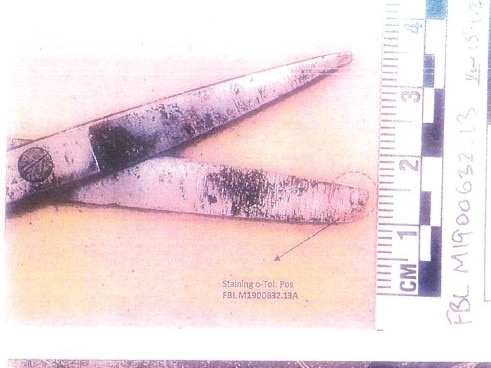
She said there was only “a very short window of opportunity for any meaningful attack”.
“Kumanjayi Walker was restrained in seconds, so there was a very short space of time that he was able to move his upper arm and deploy the scissors to any body part of any of the police officers,” she said.
“They were blunt, the dynamic (upper) blade’s slightly more pointy but the blades were closed as far as we know, so that means it’s a thick, blunt tip.”
Dr Tiemensma also said an autopsy she performed on Mr Walker revealed he had minor “blunt force injuries” to his face, sustained within the hours leading up to his death.
“It could be a blow by a fist, as I say, it’s not the only thing, it could be movement across a rough surface, it could be a fall,” she said.
Under cross examination by defence barrister, David Edwardson QC, Dr Tiemensma defended her opinion that the scissors were likely closed during the struggle.
Mr Edwardson suggested Dr Tiemensma actually “can’t tell because you can’t see, can you, on the video, whether they were ever in an open state when he was attempting to deploy them”.
But Dr Tiemensma said if the scissors had been open she would have expected to see injuries to Mr Walker’s hands from the “cutting edges of the blades”.
“If he had the blades open, it depends on how you’re going to hold the scissors because you need to keep the blades open, he’s only using one hand so it’s going to be quite difficult to keep the blades open and then exert enough pressure,” she said.
“It may be that he’s holding on to one cutting edge but then you would expect to see injuries to his hands that wasn’t there.”
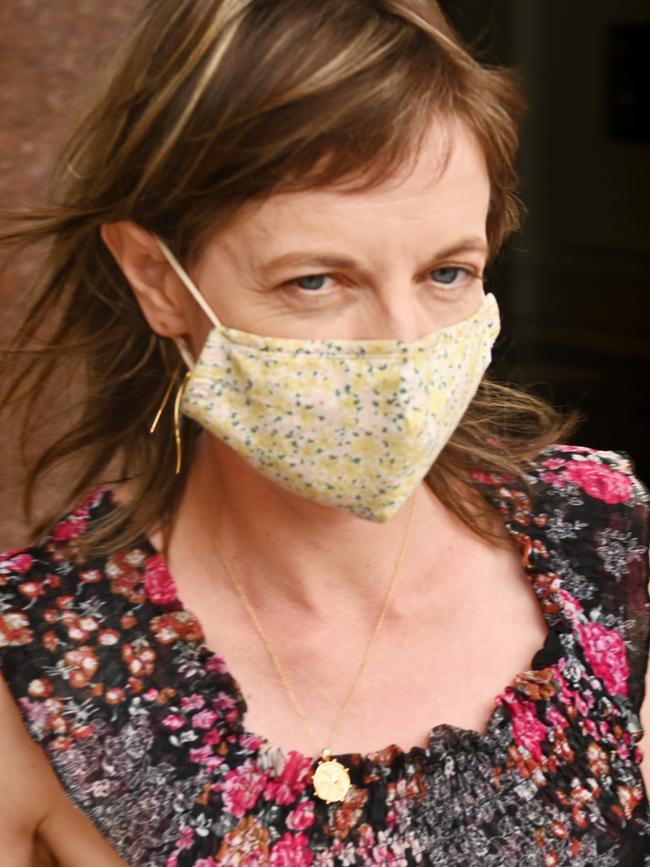
Dr Tiemensma also defended having written her expert report before ever having physically seen the scissors, other than in photographs.
Mr Edwardson suggested the photos were “incapable of identifying how sharp the scissors were” but Dr Tiemensma said it wasn’t unusual for her to “not have physically handled the scissors”.
“Often when I do my autopsies when I’m asked about opinions on weapons, most frequently I’m only seeing images and that’s something that I’m accustomed to doing,” she said.
“I thought from the images I could get a very good idea of what the exact edges looked like, how big it was, the only thing I couldn’t see was the tip of the scissors.”
The trial continues.
Shot teen ‘could have survived’ if health clinic had not been evacuated, court hears
KUMANJAYI Walker “could have survived” being shot three times by Constable Zach Rolfe if health clinic staff had not been evacuated from Yuendumu earlier that day, a court has heard.
On Monday, Queensland University professor of military medicine and surgery and serving Army officer, Michael Reade, told Rolfe’s murder trial Mr Walker would have had a 99 per cent chance of surviving his wounds if he had had immediate access to emergency surgery.
But while Dr Reade praised Rolfe and his fellow officers for their “focused” and “attentive” first aid treatment at the scene, he said Mr Walker “was going to die regardless of any efforts by the police officers present”.
“I believe that they, first of all appreciated the gravity of the situation, that they applied themselves to implementing their protocols and their training, they sought equipment with a sense of urgency and they applied that to the rendering of first aid as best they could,” he said.
“They called for help at the earliest possible opportunity, both prehospital and then from the ambulance dispatch officer when they arrived at the police station and really, I fail to see how anything more could have been done by them.”
Dr Reade said while the closest hospital that could have provided the treatment required to save Mr Walker’s life was at Alice Springs, it was possible intervention from clinic staff could have helped him hold on for long enough to make it there alive.
“I do have some knowledge of that type of clinic, having worked in that environment, very briefly, many years ago and I’m aware of descriptions of that clinic that have been given, that have been tendered in evidence as well, and from that knowledge, I believe that a limited number of those prehospital interventions that optimally would have been applied, could have been applied, but others would not,” he said.
“So for example, I don’t believe the remote area nursing staff, who might otherwise have been at that clinic, would have been trained or equipped to undertake intubation, mechanical ventilation, I don’t believe they would have been trained or equipped to provide blood transfusions and so on.”
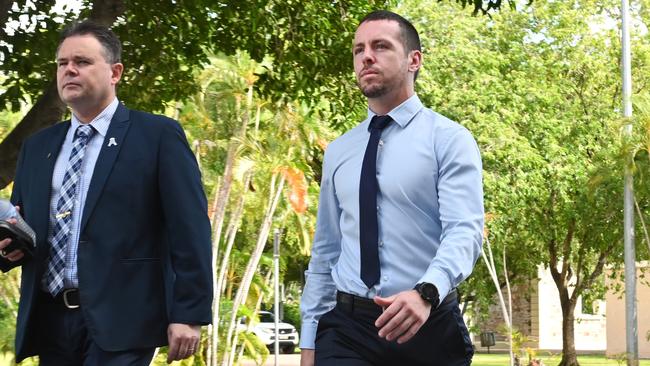
But Dr Reade said the situation was purely hypothetical and if asked to assign a probability to Mr Walker’s chances of surviving had the clinic staff been available, “I would literally be guessing”.
“It’s a foolish doctor that will ever say anything is certain but had this wound pattern been sustained in close proximity to an advanced surgical hospital, I would have expected him to survive,” he said.
“I would be very surprised if he had succumbed to those injuries.”
Earlier this month, Superintendent Jody Nobbs told the court the sergeant in charge at Yuendumu on the day, Julie Frost, had told him the clinic staff had left “on the basis of perceived safety risks”.
“They asserted they were the victim of a series of unreported property crimes that preceding night, Sgt Frost suspected that Kumanjayi Walker may have been a part of that although had no definitive evidence to support that assertion,” he said.
Rolfe has pleaded not guilty to all charges and the trial continues on Tuesday.
Scissors used to stab Constable Zach Rolfe tendered
JURORS in Zach Rolfe’s murder trial have been shown the scissors Kumanjayi Walker used to stab the NT Police officer in the shoulder before he shot and killed him during an arrest in 2019.
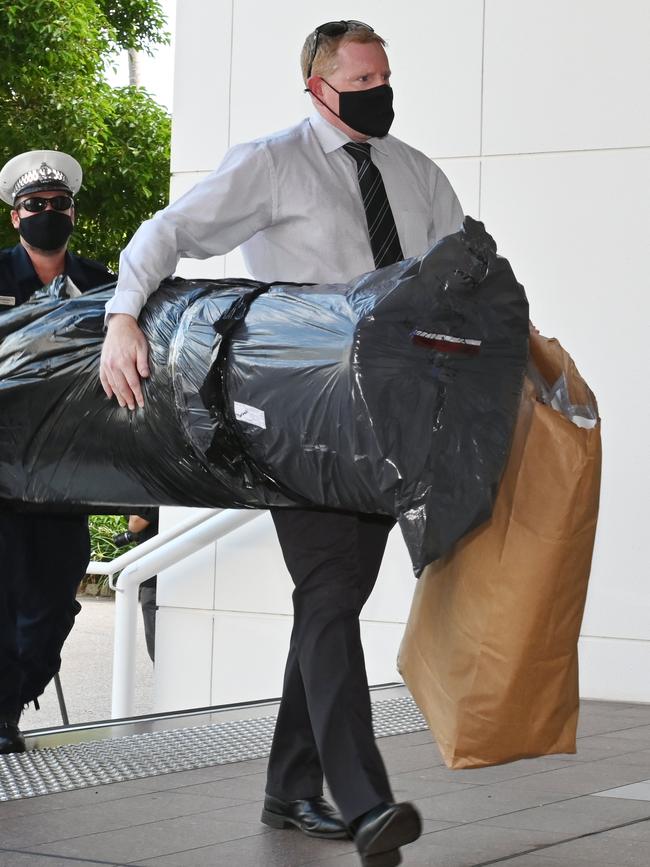
Rolfe has pleaded not guilty to all charges after fatally shooting the 19-year-old in Yuendumu on November 9.
The scissors were formally tendered in Rolfe’s trial through crime scene examiner, Senior Constable Ian Spilsbury, as the trial entered its third week on Monday.
Constable Rolfe’s Glock pistol that fired the fatal shots and the blood-stained mattress on which the shooting occurred were also shown to jurors in the trial on Monday.
The scissors were tendered along with Rolfe’s police uniform shirt he was wearing at the time of the incident, as well as his undershirt and tactical vest.
As the items were submitted to the court, Justice John Burns told jurors they would have access to the objects as they deliberated but reminded them to protect themselves from biohazards.
“If, for some reason, you feel that it is necessary to examine that item (the scissors), please ask the sheriff’s officer to provide you with gloves,” he said.
The Glock pistol was placed into secure storage to be made available to the jury on request.
The trial continues.





